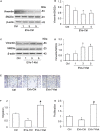Reversal of Endothelial Extracellular Vesicle-Induced Smooth Muscle Phenotype Transition by Hypercholesterolemia Stimulation: Role of NLRP3 Inflammasome Activation
- PMID: 33409276
- PMCID: PMC7779768
- DOI: 10.3389/fcell.2020.597423
Reversal of Endothelial Extracellular Vesicle-Induced Smooth Muscle Phenotype Transition by Hypercholesterolemia Stimulation: Role of NLRP3 Inflammasome Activation
Abstract
Recent studies reported that vascular endothelial cells (ECs) secrete NLR family pyrin domain-containing 3 (NLRP3) inflammasome products such as interleukin-1β (IL-1β) via extracellular vesicles (EVs) under various pathological conditions. EVs represent one of the critical mechanisms mediating the cell-to-cell communication between ECs and vascular smooth muscle cells (VSMCs). However, whether or not the inflammasome-dependent EVs directly participate in the regulation of VSMC function remains unknown. In the present study, we found that in cultured carotid ECs, atherogenic stimulation by oxysterol 7-ketocholesterol (7-Ket) induced NLRP3 inflammasome formation and activation, reduced lysosome-multivesicular bodies (MVBs) fusion, and increased secretion of EVs that contain inflammasome product IL-1β. These EC-derived IL-1β-containing EVs promoted synthetic phenotype transition of co-cultured VSMCs, whereas EVs from unstimulated ECs have the opposite effects. Moreover, acid ceramidase (AC) deficiency or lysosome inhibition further exaggerated the 7-Ket-induced release of IL-1β-containing EVs in ECs. Using a Western diet (WD)-induced hypercholesterolemia mouse model, we found that endothelial-specific AC gene knockout mice (Asah1fl/fl/ECCre) exhibited augmented WD-induced EV secretion with IL-1β and more significantly decreased the interaction of MVBs with lysosomes in the carotid arterial wall compared to their wild-type littermates (WT/WT). The endothelial AC deficiency in Asah1fl/fl/ECCre mice also resulted in enhanced VSMC phenotype transition and accelerated neointima formation. Together, these results suggest that NLRP3 inflammasome-dependent IL-1β production during hypercholesterolemia promotes VSMC phenotype transition to synthetic status via EV machinery, which is controlled by lysosomal AC activity. Our findings provide novel mechanistic insights into understanding the pathogenic role of endothelial NLRP3 inflammasome in vascular injury through EV-mediated EC-to-VSMC regulation.
Keywords: acid ceramidase; ceramide; endothelial cells; extracellular vesicles; lysosome.
Copyright © 2020 Yuan, Bhat, Samidurai, Das, Zhang and Li.
Conflict of interest statement
The authors declare that the research was conducted in the absence of any commercial or financial relationships that could be construed as a potential conflict of interest.
Figures







Similar articles
-
Contribution of Hepatic Steatosis-Intensified Extracellular Vesicle Release to Aggravated Inflammatory Endothelial Injury in Liver-Specific Asah1 Gene Knockout Mice.Am J Pathol. 2023 Apr;193(4):493-508. doi: 10.1016/j.ajpath.2022.12.007. Epub 2023 Jan 10. Am J Pathol. 2023. PMID: 36638912 Free PMC article.
-
Endothelial acid ceramidase in exosome-mediated release of NLRP3 inflammasome products during hyperglycemia: Evidence from endothelium-specific deletion of Asah1 gene.Biochim Biophys Acta Mol Cell Biol Lipids. 2019 Dec;1864(12):158532. doi: 10.1016/j.bbalip.2019.158532. Epub 2019 Oct 21. Biochim Biophys Acta Mol Cell Biol Lipids. 2019. PMID: 31647995 Free PMC article.
-
Endothelial Acid Sphingomyelinase Promotes NLRP3 Inflammasome and Neointima Formation During Hypercholesterolemia.J Lipid Res. 2022 Dec;63(12):100298. doi: 10.1016/j.jlr.2022.100298. Epub 2022 Oct 15. J Lipid Res. 2022. PMID: 36252682 Free PMC article.
-
Extracellular vesicles in atherosclerosis and vascular calcification: the versatile non-coding RNAs from endothelial cells and vascular smooth muscle cells.Front Med (Lausanne). 2023 Jul 4;10:1193660. doi: 10.3389/fmed.2023.1193660. eCollection 2023. Front Med (Lausanne). 2023. PMID: 37469665 Free PMC article. Review.
-
Impact of lysosome status on extracellular vesicle content and release.Ageing Res Rev. 2016 Dec;32:65-74. doi: 10.1016/j.arr.2016.05.001. Epub 2016 May 26. Ageing Res Rev. 2016. PMID: 27238186 Free PMC article. Review.
Cited by
-
Extracellular vesicles in vascular remodeling.Acta Pharmacol Sin. 2022 Sep;43(9):2191-2201. doi: 10.1038/s41401-021-00846-7. Epub 2022 Jan 12. Acta Pharmacol Sin. 2022. PMID: 35022541 Free PMC article. Review.
-
Oxidative Stress, Atherogenic Dyslipidemia, and Cardiovascular Risk.Biomedicines. 2023 Oct 26;11(11):2897. doi: 10.3390/biomedicines11112897. Biomedicines. 2023. PMID: 38001900 Free PMC article. Review.
-
Contribution of Hepatic Steatosis-Intensified Extracellular Vesicle Release to Aggravated Inflammatory Endothelial Injury in Liver-Specific Asah1 Gene Knockout Mice.Am J Pathol. 2023 Apr;193(4):493-508. doi: 10.1016/j.ajpath.2022.12.007. Epub 2023 Jan 10. Am J Pathol. 2023. PMID: 36638912 Free PMC article.
-
How vascular smooth muscle cell phenotype switching contributes to vascular disease.Cell Commun Signal. 2022 Nov 21;20(1):180. doi: 10.1186/s12964-022-00993-2. Cell Commun Signal. 2022. PMID: 36411459 Free PMC article. Review.
-
GDF11 alleviates neointimal hyperplasia in a rat model of artery injury by regulating endothelial NLRP3 inflammasome activation and rapid re-endothelialization.J Transl Med. 2022 Jan 15;20(1):28. doi: 10.1186/s12967-022-03229-6. J Transl Med. 2022. PMID: 35033112 Free PMC article.
References
-
- Adhikari N., Shekar K. C., Staggs R., Win Z., Steucke K., Lin Y. W., et al. (2015). Guidelines for the isolation and characterization of murine vascular smooth muscle cells. A report from the international society of cardiovascular translational research. J. Cardiovasc. Transl. Res. 8 158–163. 10.1007/s12265-015-9616-6 - DOI - PMC - PubMed
-
- Arriola Benitez P. C., Pesce Viglietti A. I., Gomes M. T. R., Oliveira S. C., Quarleri J. F., Giambartolomei G. H., et al. (2019). Brucella abortus infection elicited hepatic stellate cell-mediated fibrosis through inflammasome-dependent IL-1beta production. Front. Immunol. 10:3036 10.3389/fimmu.2019.03036 - DOI - PMC - PubMed
Grants and funding
LinkOut - more resources
Full Text Sources
Molecular Biology Databases

